Archive for the ‘learn to make repairs’ Category
Friday, February 13th, 2009
.
.

Here are the final numbers on the rental property that I purchased.
Price: $106,000
Interest rate: 5.125%
Term: 30 years
Down payment: $21,200
Principal & Interest: $457.37
Taxes & Insurance: $128.87
Total monthly payment: $586.24
Estimated rent: $770
The townhouse is 1100 sq.ft., 2 beds & 2 baths, washer, dryer, carport, and small back yard. It has a great central location and should rent easily. I have another property nearby that is very easy to rent.
It needs some cleanup and repair work in the kitchen, fire alarms, blinds in the windows, new toilet sets, etc. There is nothing big that we have to do to it. With my wife and kids pitching in, we should have it ready to go by the end of the weekend.
Here are a few more photos of the kitchen, the living room, and the back yard.




 Subscribe in a reader
Subscribe in a reader
Share this: del.icio.us | Digg | Ma.gnolia | Reddit | Stumble Upon |
Tags:Fix em Up Rent em Out, fixer upper houses, rental houses, townhouse
Posted in buying fixing renting rehabs, buying real estate, fixer uppers, fixer-upper business, fixing rental houses, house repair, house repairs, investing, investing in real estate, investing in your spare time, investment house, investment property, investments, investmet properties, learn repair skills, learn to invest in real estate, learn to make repairs, new purchase, rental house improvements, rental houses, rental properties, rental property, rentals, renting, repair, repairing properties, repairing rental houses, repairs, townhouse | 7 Comments »
Monday, October 20th, 2008
 .
.
I’m pleased to announce that my book, “Fix em Up Rent em Out,” is an Award-Winning Finalist in the Real Estate category of the National Best Books 2008 Awards, sponsored by USA Book News.
Top 50 Amazon Reviewer D. Blankenship says,
What this work does give you is ideas and an outline, that through hard work, common sense, and a bit of luck, you can do quite well for yourself and have a bit of fun while you do it. The author is quick to point out the down side of every aspect of this business and points out ways, if there are any, to avoid them. On the other hand, the author does a wonderful job of pointing out the positive. He not only emphasizes the financial aspects, but does a very nice job of drawing attention to the many side benefits involved, and there are many of these! I like the way that the author directs your attention to the fact that a job well done is a wonderful feeling. The author has listed given us a great list of other books and resources to turn to which I find most helpful. Actually, his list of places to go for information is almost worth the price of the book alone.
A complete list of winners and finalists in each category can be found at:
http://www.usabooknews.com/bestbooksawards2008.html.
 Subscribe in a reader
Subscribe in a reader
Share this: del.icio.us | Digg | Ma.gnolia | Reddit | Stumble Upon |
Tags:best book awards, Fix em Up Rent em Out, USA Book News
Posted in book award, buy rental property using refinance home, buying fixing renting rehabs, buying foreclosures, buying real estate, career changes, excellent real estate books, Fix em Up Rent em Out, fixer upper book, fixer upper houses, fixer uppers, fixer-upper business, fixing rental houses, how I got started in fixer uppers, How to start your own house fix up and rental busines, invest real estate repai and sell or rent, investing book, investing in real estate, investing in your spare time, investment property, investmet properties, learn to invest in real estate, learn to make repairs, real estat investing, real estate books, safe ways to invest in real estate | 1 Comment »
Monday, September 1st, 2008
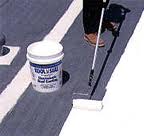 ‘
‘
Investment House Search Update
Despite the debacle last month, my wife and I are back to beating the bushes looking for our next “dream” fixer-upper house. Our plan is to find another one that we can live in while we repair it. That has worked out pretty well on the one we are living in now.
Of course, if a great deal for a regular rental pops up, we’d probably grab that too.
Rains = Leaks
We got some heavy rain Saturday. I received a call from a tenant Saturday night. She reported three leaks in her house. I knew it was time to re-coat the roof last spring, but I thought it would hold out throught one more rainy season. I was wrong.
So, flat roofs being what they are, the roof has to be dry before it can be patched. And, there has to be no threat of rain, or the coating will just wash off again. Been there, done that.
There is a 30% chance of rain today, but for the rest of the week the forecast is 0%. Tomorrow ought to be a good day to take care of it.
Tags:dream fixer upper house, leaky roofs, roof coating, roof repairs
Posted in buy, do it yourself, fence repair, house repair, house repairs, investment house, leaks, learn repair skills, learn to make repairs, making repairs, rain, repair, repairing properties, repairing rental houses, repairs | 1 Comment »
Thursday, August 21st, 2008
Tags:fixer upper house business, home repairs, lean to make repairs, making repairs
Posted in buying fixing renting rehabs, do it yourself, Fix em Up Rent em Out, fix up houses, fixer upper houses, fixer uppers, house repair, house repairs, learn repair skills, learn to make repairs, making repairs, painting, rental property, repair, repair books, repairing properties, repairing rental houses, repairs | 3 Comments »
Wednesday, February 6th, 2008
*
Following the outline from “Real Estate Investing for Dummies,” aimed at investors in fixer upper houses, we now move to the property inpection part of due diligence.
You have made an offer on a house, it has been accepted by the seller, and you are now in a period where you must determine whether or not the house is really worth puchasing. If you inspect the property and the physical condition is not satisfactory, almost all purchase contracts allow you to gracefully back out of the deal with no loss of earnest money.
Even if the investment property looks good on paper, and your pre-offer inspection didn’t unearth any skeletons, a wise investor will always do a thorough physical inspection before purchasing.
Although we investors tend to be frugal (see, skinflints), this is not the time to cut corners. You need an extensive inspection by qualified experts. I mentioned in an earlier post that I have a handyman/friend who has extensive experience in the construction & building trades, who inspects my investment properties. Unless you know someone that has that kind of background, you ought to hire someone who does.
Almost always, the inspection pays for itself. You will find problems in need of repair that are of far greater value than what you will pay the inspector. And the good part is, the seller will have to pay for the repairs if he wants to sell the house.
Many investors use a two-track approach to property inspection. You are looking for two types of problems:
1. Patent defects — those which are more superficial and can be spotted by merely looking at the property. These include broken doors, cracks in walls & ceilings, and spots in ceilings indicating a leaky roof.
2. Latent defects — those which are not visible to the naked eye, and are only identified through delving deep into the bowels of the house where few have treaded. In fact some potential problems, such a water pipes inbeded in the slab would be nearly impossible to evaluate. In fact, you couldn’t evaluate it at all unless you had a disclosure from the seller.
Next Time: Disclosure Requirements

 Subscribe in a reader
Subscribe in a reader
Share this: del.icio.us | Digg | Ma.gnolia | Reddit | Stumble Upon |
Tags:due diligence, fixer upper houses, inspecting the property, property inspection
Posted in due diligence, fixer upper houses, fixer uppers, fixer-upper business, fixing rental houses, house inspection learn a valuable lesson, inspecting investment properties, inspections, learn to invest in real estate, learn to make repairs, legal information, making repairs, negotiating, overcoming obstacles, problems with closing, property damage, property inspection | No Comments »
Friday, December 21st, 2007
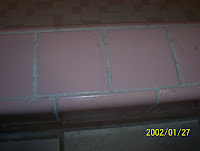
A common problem encountered in older houses is the grout can look dirty. For the 1957 fixer upper house that my wife and I are presently working on, the tile grout in the master bathroom was dingy (see picture above). My plan since I bought the house was to remove the old grout and replace it with new grout.
However, last week before beginning the grout removal, I checked my copy of Home Depot’s book “Tiling 1-2-3“. The book suggested cleaning the grout to bring it back to its old glory.
So I purchased some Agua Mix Grout Deep Clean, and some White Tile Grout Coating for good measure.

First, I used my grout saw to lightly scrape off dark spots in the grout.
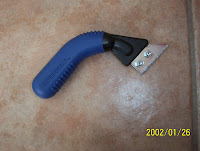
Then, I used the Grout Deep Clean, which to my surprise, actually did make the grout look cleaner. I let the liquid “dwell” on the grout for 5 minutes, I “agitated” it with a scrub brush, then I waited 2 hours for it to dry. But it still wasn’t as bright as I would have liked.
Next, I liberally applied the Tile Grout Coating to the grout.
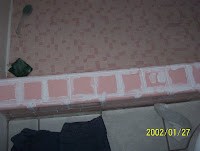
The coating did a remarkably good job of coloring the grout to a strong color of white. I was very happy with the results. After the coating dried I applied grout sealer.
After all was done, the grout looked like this.
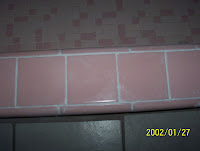
So, the lesson is, as long as the grout is not badly cracked, you’re better off cleaning and coating the old grout. It can save you a lot of time.
Info on Terry’s Book

 Subscribe in a reader
Subscribe in a reader
Share this: del.icio.us | Digg | Ma.gnolia | Reddit | Stumble Upon |
Tags:Fix em Up Rent em Out, fixing tile grout in old houses, repairing fixer upper houses, tile grout coating
Posted in fix up houses, fixer upper houses, fixer uppers, fixer-upper business, fixing rental houses, grout, grout replacement, house repair, house repairs, learn repair skills, learn to make repairs, making repairs, property damage, real estate books, rehab, rental house improvements, repair, repair books, repairing properties, repairing rental houses, repairs | 1 Comment »
Friday, November 16th, 2007
 In the fixer upper rental house business, we must constantly monitor the status of our property.
In the fixer upper rental house business, we must constantly monitor the status of our property.
I was reminded of this again when we discovered that we had termites in one of our bedrooms. This is a fixer upper house that we are living in as we make repairs; soon to be a rental house. My son bumped his foot against the floor trim and found that there was no longer any wood trim there. All that was left was the the shell of the paint in the form of the trim. The wood had been completely eaten by termites.
Hiring a Pest Control Professional
I usually like to do all fix-up type repairs myself, but this is a case where I let the exterminators (no relation to the California governor) do the work. The first few companies I called would not give me a quote over the phone. The one company that gave me a “rough estimate” came in at a budget busting $1500 to $2,000 for a 1600 sq.ft. house. The job must be based on the square footage of the house, so it’s not rocket science to calculate the cost. It makes it impossible to compare companies if they all have to come to the house before they can give me an estimate! They think that after you invest the time to have them come over, you’ll just fall for their sales pitch, rather than spend any more time finding the best deal (and at the same time you’re concerned that your house is crumbling from the relentless termite onslaught).
So, I kept calling. After several more calls I connected with A-OK Termite and Pest Control and they really were “A-OK” because they gave me a bid of $650 without a house business. They did the job last Saturday.
Termite Living Habits

Yikes! Termites
Here in the desert southwest, we have subterranean termites, which I believe are the singlemost common type. They live in colonies deep within the ground, sometimes to depths of 25 feet. Termites work their way up through the soil from their nest and enter any wood they can. Termites can gain entrance by crawling up the sides of foundations, building mud shelter tubes to shield them from light, or they can go up hollow sections in block foundations or up cracks in the poured concrete foundations.
Every 48 hours or so termites must return to the soil to get moisture or they will die. The exterminator (again, no connection to Arnold) sets up a barrier of chemicals in the soil that the termites cannot pass through. They usually inject chlordane into the the soil every eighteen inches around the entire house. The same procedure can be done inside the house.
Even if only one part of the house is infested, the entire house must be termite-proofed or the termites will migrate to the untreated parts.
The time it takes termites to do serious damage varies from only a couple of years to 10 or more years. So, if you think you might have termites, don’t put off taking care of them too long. If it’s been 5 years since the last treatment it’s time to have the house inspected.

 Subscribe in a reader
Subscribe in a reader
Share this: del.icio.us | Digg | Ma.gnolia | Reddit | Stumble Upon |
Tags:dealing with termites, fixer upper rental house, hiring contractors, live in fixer upper house while making repairs, making repairs, termites in rental houses
Posted in contractor calculations, contractors, do it yourself, fix up houses, fixer upper houses, fixer uppers, fixer-upper business, fixing rental houses, investment property, learn to make repairs, live in, making repairs, managing tenants, property damage, repairing properties, repairing rental houses, repairs, Uncategorized | No Comments »
Wednesday, November 7th, 2007

If your circumstances are such that it is impossible for you to start investing in real estate today, you can start by just meandering in that direction, like a lazy mountain stream.
You can program your mind to pay attention to anything related to real estate. Cut articles out of the newspaper, buy books at book sales, ask friends and co-workers how they purchased their house, watch for free classes or seminars. You can be constantly learning and preparing for the day you will purchase your first fixer-upper property. As Paul and Sarah Edwards point out in Making it on Your Own, “virtually anything you need to know is available to you through books, tapes, workshops, seminars, public education programs, consultants and training programs.”
I meandered for approximately 11 years before purchasing my first investment property. Now I wish I had started sooner, but you can’t begin until you have the desire and the knowledge. Sometimes, desire and knowledge can be acquired simply by observing someone else operating a successful business.

 Subscribe in a reader
Subscribe in a reader
Share this: del.icio.us | Digg | Ma.gnolia | Reddit | Stumble Upon |
Tags:investing in real estate, Making it on Your Own, meander towards fixer upper classes, Paul and Sarah Edwards
Posted in fixer upper houses, fixer-upper business, fixing rental houses, How to start your own house fix up and rental busines, investing in real estate, investing in your spare time, learn repair skills, learn to invest in real estate, learn to make repairs, real estate investing | 1 Comment »
Tuesday, October 23rd, 2007
Sunday was a day to continue work on our present fixer upper house.
The house had a leaky cooler on the roof when we bought it. I repaired the roof with E-LAS-TEK rubberized roof coating (for flat roofs like we have in Tucson), but I had not repaired the ceiling until Sunday It had been stained by the water from the roof.
(The picture dates are wrong. I didn’t update the camera last time I changed batteries.)

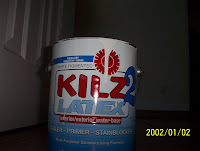
I scraped the old paint away above the bathtub. I used joint compound (“mud”) to patch the spot. After the mud dried, I brushed on “Kilz” to cover the stains and to prevent any future leaks from the roof to stain the ceiling. Later, I will paint it again with the white latex paint we are using for the bathroom.

Another project I worked on Saturday was to continue painting the house roof overhang. It could easily have been 50 years since some sections of the overhang were painted, other sections never had paint. The wood absorbs the paint like a sponge. The wood is so old that, in places, a it has a hair-like covering. Before painting, I scape off the hair (I give it a shave) with one of my “mud” spatulas. You could probably use a wire brush too, but it comes off pretty easy with the spatula.
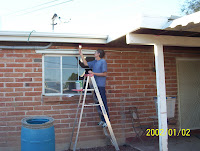
I started off using the cheap $1.00 “throw-away” brushes that you can buy at Home Depot. They didn’t hold the paint too well, so now I am using a more expensive brush which is working a little better. The paint spreads a little easier.
Most people wouldn’t notice whether or not the overhang was painted. However, we want this house to last a long time, so the paint goes on.
As I mentioned in an earlier blog, my wife & I do the repairs on this house in fits and starts. Since we live in the house, we don’t have the the pressures to do it rapidly, like we did for our last fixer-upper house. (For more info, see my latest book “How to Turn Your Home into a Rental House, Instead of Selling It).
For that one, the “Planeta” house, we worked late into the evenings and we would take turns getting up early the next morning, to put a few hours in before going to work. One of us would stay home with the sleeping kids. Making the monthly mortgage payments and all the repair costs that we were racking up, gave us real motivation to finish and get a renter in there ASAP.
In the present situation, it works best for me when I set easy short-range goals. Right now my goal is simply to get up early & paint for one hour before I eat breakfast and get ready for work. On weekends I can do more, but just an hour a day keeps the ball rolling.

 Subscribe in a reader
Subscribe in a reader
Share this: del.icio.us | Digg | Ma.gnolia | Reddit | Stumble Upon |
Tags:ceiling repair for fixer upper, cheap paint brushes, do it yourself, e-las-tek, kilz, living in fixer upper house, painting, throw away paint brushes, turn your home into a rental house, turn your home into a rental property
Posted in do it yourself, fix up houses, fixer upper houses, fixer uppers, fixing rental houses, house repair, house repairs, how to turn your home into a rental property, learn repair skills, learn to make repairs, making repairs, painting, repairing properties, repairing rental houses, repairs, turning my home into rental property, turning your home into a rental property | No Comments »
Sunday, October 7th, 2007

As fixer upper rental house business owners, its good to know how to do as many repair jobs as possible, however, when a job is too technical and beyond your abilities, or too tedious, like a large painting job, it’s time to contract the job out.
The secret in dealing with contractors is that it’s better to pay by the job instead of by the hour. If you pay by the hour, whoever you contract with can bleed you dry by working many more hours than anticipated. If you can get the contractor to set a fee before beginning the job, he absorbs the cost of working the extra hours instead of you.
This technique works well if you are hiring a non-professional, like high school students to paint outside trim work for you. However, it doesn’t always work so well if you are hiring a highly skilled electrician or plumber. Sometimes they’ll give you a set price, but mostly you pay them by the hour.
I have a highly skilled handy man I call in for jobs over my head, and I always pay him by the hour. He often will make repairs at my rental properties at odd hours and respond quickly to emergency situations. Without him, I’d almost have to quit may day job to keep up with repairs. When you have someone like that, you do whatever you have to, to hang on to them.

 Subscribe in a reader
Subscribe in a reader
Share this: del.icio.us | Digg | Ma.gnolia | Reddit | Stumble Upon |
Tags:contracting out jobs, cutting repair costs, fixer upper rental house owners, handyman, pay by the hour not by the job
Posted in fixer upper houses, fixer uppers, fixer-upper business, fixing rental houses, house repair, house repairs, learn repair skills, learn to make repairs, making repairs, rental house improvements, rental management, repairing properties, repairing rental houses, repairs | 2 Comments »














